Ovamboland, Namibia 17-20 May 2013, with flashbacks to the 1970s
After leaving the Etosha National Park though the King Nehano Gate, and having driving licences and car papers checked by the police, the flat grassland continued beyond the park, but the herds of grazing animals on the other side were cattle, of which there were many, but there was no sign of human habitation.
After about 20 km travelling on a good gravel road we came to the main tarred road from Tsumeb to Ondangwa, and the vegetation changed again to thirstveld bush, but it was altogether different from the last time I had travelled along this road over 40 years ago. Then it was uninhabited bush, now it was thoroughly urbanised, or at least like a peri-urban area, with village succeeding village. There were a few stretches of road with a 120 km/h speed limit, but it did not feel right to travel at more than 90 along them, and then there would be an 80 sign, followed by two 60 ones. All along the road were bars and shebeens with fanciful names, mostly built with concrete blooks plastered and corrugated iron roofs. Every second shop advertised MTC, the main Namibian cellphone provider.
There was no sign of traditional Ovambo homesteads with their labyrinths at all. It was all square houses of the type regarded as so desirable by 19th-century Western missionaries, though I’m not sure that they would have been pleased to see their dreams fulfilled in bars and shebeens. That continued until we reached signs of the typical Ovamboland vegetation, the tall palm trees, but instead of the open parkland, it was filled with vistas of ugly concrete buildings. There were stagnant polluted pools with rubbish in them.
Forty years ago Ovamboland barely had a cash economy, and the economy was based almost entirely on subsistence agriculture. Now it was clearly cash and service industries. I wondered how much of the change had been due to the South African military occupation of the 1970s and 1980s, and how much to the 20 years of independence since then.
We reached Ondangwa at about 2:00 pm, 256 km after leaving Halali, and went shopping for groceries at a Shoprite Usave store, which was Friday afternoon busy. Val went in and shopped, while I stayed with the car, as Nancy Robson had warned us about petty crime. We left again about 2:30, and drove towards Oshikango, and almost the whole way seemed to have a 60 km/h speed limit, again with shops and bars in a continuous urban development.
We stopped to take a photo of a couple of the shops with fanciful names, the Fanny Resting Bar and the Water Melon is Life across the road. A couple of guys came and asked for R50.00. There was none of the traditional Ovambo greeting with polite enquiries about health or anything of that sort. Just “Give me fifty Rand” — not even Namibian dollars. They were wearing fairly new clothes, tshirts and so on, so did not look all that poor, so we just drove off, having seen more evidence of the cash economy. We followed Nancy Robson’s directions to Odibo, which were useful, as we would never have found it otherwise, and that too had changed so as to be almost unrecognisable, and seemed to be almost in the middle of town. The trees had grown too.
We stayed in the guest house, which had self-catering accommodation for visitors, and met old friends, among them retired bishop Nehemiah Shihala Hamupembe, and his wife Ndalipo.

Shihala Hamupembe with daughter Ndahafa on Durban beach in 1975, when he and his family spent a vac with us when he was a student at the Federal Theological Seminary in Pietermaritzburg
When I first met him in 1970 he was the youth organiser for the Anglican Church in Ovamboland, and was on his way to Zambia for a year-long youth leadership course at the Mindolo Ecumenical Centre there. He stayed with us in Windhoek for a couple of days before leaving, and as a result of a chance message over heard on a police radio, we thought that the police had been given orders to prevent his departure, so hastily brought it forward a couple of days. Timothy Shimbode, the son of a priest in Ovamboland, who worked as a baggage handler at the airport, told me afterwards that Shihala had been questioned quite a bit by the police before he left. On his return at the end of the year he spent Christmas with us in the house we were staying in in Klein Windhoek, and the police questioned him about not having a pass. When we pointed out that he had just arrived back in the country, and the pass office was closed as it was a public holiday, they left. They weren’t looking specifically for Shihala, though; they had been called by a nosy neighbour who didn’t like the idea of blacks and whites staying together at the house.
A year later, in December 1971, the Diocesan Standing Committee had met and considered a manifesto on theological education, in which I had proposed the use of theologicval education by extension and the ordination of self-supporting priests and deacons in local congregations in Ovamboland and elsewhere. The standing committee accepted the manifesto and appointed me as convener of an education subcommittee to implement it, with Sihala Hamupembe, the Revd Willy van der Sijde and Toni Halberstadt as the other members. Within a couple of months Toni and I were deported from Namibia, so not much came of it at the time.
But now, more than 42 years later, we attended a graduation ceremony in St Mary’s Church in Odibo, presided over by Bishop Emeritus Shihala Hamupembe, where the things we had proposed at that earlier meeting had been fulfilled.
At the graduation ceremony 13 students received certificates in counselling, two received the award in theology, and 16 received the Certificate of Competency in Theology, four with distinction. The choir of the Diocesan School of Theology and Ministry sang several items.
It was rather strange to see first beginning of something, and the way it had developed after forty years, without having seen anything in between. But that was the same with Shihala Hamupembe. I had known him as a student in the 1970s, and was meeting him again as a retired bishop, but had seen nothing of what happened in between.
In 1975 he was a student at the Federal Theological Seminary in Pietermaritzburg, and as it was too far to travel back to Namibia for the July vacation, he and his family came to stay with us in Durban North. I was banned at the time, and when our church youth group wanted to go to Zululand for a camp, I could not leave Durban, so Sihala went with them as adult chaperon, putting his training as a youth leader from Zambia to good use. It was probably unusual for South Africa in those days for a bunch of middle class white kids to go on a camping trip with a black youth leader, but if the parents had any objections, they never voiced them, or at least not in my hearing.
At the graduation Bishop Sihala spoke of those days, that when South Africa was under Namibia, it was easy for Namibians to go to South Africa for theological education — all they needed was identity documents. Now, however, they demand a large deposit for students, in case they have to deport them, and also medical aid, and, as he pointed out, in Namibia even the bishops don’t have medical aid.
That is rather sad for education in South Africa. At one time we were talking of having an Orthodox Seminary in southern Africa, to serve the whole subcontinent, as the one in Nairobi serves East Africa, but if there ever is such a thing, South Africa will not be the place for it, because of the bureaucratic hurdles that are placed in the way of educational institutions, and especially foreign students. A pity, because by becoming an educational centre for Southern Africa, South Africa could also improve its own education system which still bears the marks of the apartheid period and the legacy of Bantu and Christian National Education. Zimbabweans still tend to be much better educated than South Africans. Justin Ellis said that that is probably a result of the work of Garfield Todd and his disciples, who had a vision for education in Zimbabwe long before it became independent, and laid a strong foundation that persists to the present. In South Africa Bantu Education weakened whatever foundation there was, and very little has been done in the last 20 years to trasnsform it, despite all the talk about “transformation.” The few visionary educationists that we have had, like John Samuel, have been sidelined.
There was another similar encounter that afternoon, when Sister Gertrude took Val and me to see Joseph Kakehongo, a venerable old man, at Onekwaya, about 30 km from Odibo. We we were treated to a sumptuous feast at the Kakehongo household, and, as with Shihala Hamupembe, I had not seen Joseph Kakehongo for about 40 years.
I had met Joseph when I first went to Namibia in 1969 and he was a schoolboy at the Döbra Catholic High School just outside Windhoek. On Sunday mornings after church services in Windhoek Dave de Beer and I went out to hold services at isolated camps for road and railway workers out in the bush. Most of the workers were contract workers from Ovamboland, and we often used to pick up Joseph on the way, and he would come and help with the services, and translate things into Kwanyama.
In 1973 Joseph and Steve Singleton from the UK attended a Methodist youth leadership training course in Durban when I was living there, and I saw quite a bit of them, So again, I had the rather strange experience of meeting someone I had known as a student, and now seeing him in retirement, without having seen anything that had happened in between. Joseph had had a serious heart attack earlier, and had spent several months in hospital. We met his second wife (without having ever known the first), who is a nurse and so able to look after him.
Sister Gertrude, who took us to see Joseph, was something of a surprise too. She was wearing the habit of the Community of the Holy Name, which we knew well from Zululand, where there had been four CHN convents when we lived there from 1977-1982. Sister Gertrude said she was from Lesotho, and had been in Ovamboland for 8 years, and had learned to speak Kwanyama. It was a big contrast from mountainous Lesotho, since Ovamboland is entirely flat, and children who have grown up there only see mountains in pictures in books. After visiting Joseph Kakehongo, she took us to see where she and another CHN sister were helping three local women to establish a monastery, the Community of the Good Samaritan.

Two sisters from the Community of the Holy Name in Lesotho have been helping to establish an Anglican sisterhood in Ovamboland
One person I had hoped to see was Fr Lazarus Haukongo, who also lives at Onekwaya, but unfortunately he was away at his farm. He and I had been involved in an interesting mission project in the Kaokoveld, and one of the things I had hoped to discuss with him was how it had turned out later. Abraham Hangula, an evangelist in Windhoek, had told me that there were Anglicans in the Kaokoveld, and said we should follow them up. I looking in old files in the diocesan office, and found correspondence with one Thomas Ruhozu, so I wrote to him, and when there was no reply I thought my letter must have gone astray. Then one day he suddenly appeared on my doorstep in Windhoek, having travelled 400 miles from the Kaokoveld.
The diocesan synod happened to be meeting at the time, so I was able to intoduce him to Fr Lazarus Haukongo, who knew a little Herero, and promised to visit him. I gave him some books to read, and we conversed in my limited Herero and his limited English. At the end of his stay I took him to see the Herero chief, Clemens Kapuuo, who interpreted for us, and so Thomas was able to give his version of the mission plan we had discussed, which was that he would go home and evangelise. Three months later Fr Lazarus visited him, and admitted 18 catechumens. A few weeks later he returned and baptised the 18, and admitted another 25 catechumens. Then I was deported from Namibia, and I don’t know what happened after that, but hoped to ask Fr Lazarus.
Back in the present, on Sunday morning, 19 May 2013, with the permission of Fr Johannes Kandume, the Rector of St Mary’s Church at Odibo (whose father, Fr Jonah Kandume, I had known as a priest), Val and I sang the Hours of Pascha in the chapel, and I wondered if that was the first time there had been an Orthodox service in Ovamboland. Later we attended the Anglican service, and then went to lunch with Nancy Robson, who had been born at Odibo, when her parents were working there in the early days of the Anglican mission, and had later returned to work in the hospital as a nurse. On this trip Nancy helped us a great deal by contacting some of our old friends and putting us in touch with them again.
One of the people we met over lunch was Loth-Chappel Haukongo, who remembered an epic journey we had made after the Anglican synod in Windhoek in 1971. He had an interesting scrapbook, with press cuttings of various events, one of which was a report in Die Suidwester, the National Party newspaper. It had a report of the 1970 synod, expressing shock, horror and moral outrage at the “mixed” (bont) nature of the gathering, which it compared to a hippie love fest.
But the 1971 synod was marred by tragedy, as a bakkie taking some of the synod representatives back to Ovamboland crashed on the way, and two were killed, while several others were in hospital. The bakkie was a write-off, and the ones who were less severely injured were stranded in Windhoek. So I volunteered to take some of them when I took Thomas Ruhozu back to the Kaokoveld. I didn’t have a permit to enter Ovamboland, but we decided to cross that bridge when we came to it and trust the Lord to deal with it. Among those who came with me were Loth-Chappel and Toni Halbestadt, who was then teaching at St Mary’s, Odibo.
We set out early in the morning, and dropped Thomas Ruhozu at Kamanjab (none of the rest of us had permits to enter the Kaokoveld, so that was as far as we could take him) in the late afternoon, and we drove throught the gathering dusk on the gravel roads to Outjo and Otavi, where we reached the tarred road to Tsumeb and Ondangwa.
Just before we reached Oshivelo, the gate to Ovamboland, I climbed into the back of the bakkie and hid under a mattress, while Toni drove through the gate. As we drove beyond the gate I felt one of the rear tyres going flat, but we did not want to stop within sight of the gate. When we did have to stop, we changed the wheel about midnight. On the left was the Etosha National Park, with its game-proof fence, but while we were changing the wheel we could hear a lion roaring off to the right, in the unfenced bush. Now, as I have written above, the road is all over bars and shebeens, but back then it was uninhabited bush.
We arrived at Odibo about three in the morning, and I slept on the floor of Toni’s room, and spent the next day trying to see what I could see of Ovamboland while still there, and Fr Lazarus Haukongo took me to see a couple of the parishes along the Angola border, including his own parish of Holy Cross, Onamunama. A couple of years later that ended, as the South African military occupation began, and vegetation, churches and people were systematically and forciblhy removed from the border area.
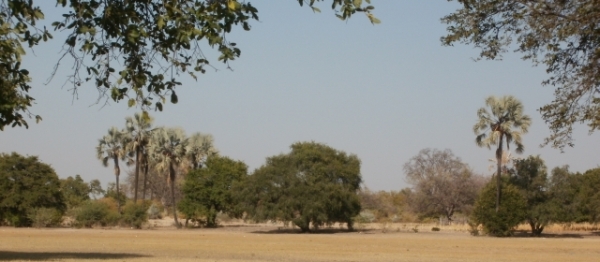
On the old road from Odibo to Oshikango, some parts of the countryside look much as they did 40 years ago
While we were reminiscing about these things Nancy remarked that people no longer liked to speak of Ovamboland, but only referred to Owambo, becauser “Ovamboland” sounded too colonial. Such are the vagaries of political correctness, because in 1970 the politically correct term, from the point of view of the National Party, was Owambo, which was the official name of the “homeland”. Since we disagreed with the homelands policy, we deliberately referred to Ovamboland, and in any case, Owambo, as we, and many Ovambo themselves, understood it, extended north of the border to include as sizeable chunk of Angola, then a Portuguese colonial territory, so we tried to avoid using the word “Owambo” to refer to the Nationalist Party’s Bantustan.
Those were also the days when Anglicans messed up demographic statistics, because the figures showed that there were more Christians than people in Ovamboland. That was because most of the Anglican parishes were within a couple of hundred metres of the border, and half the church members lived in Angola — that is, before the South African military occupation from about 1975 onwards put an end to it.
In the guest house where we were staying was another link with the past. Shirley Handura, from the diocesan office in Windhoek, was staying in Odibo for a few days to try to sort out some of the problems with the financial records of the hospital at Odibo. When I lived in Windhoek 40 years ago, in a community, Shirley’s mother-in-law, Dinah Handura, did our laundry.
Her presence showed that some things do not change.
In 1969 David de Beer, after completing his B.Com degree at Wits University, came to Odibo to be accountant at St Mary’s Hospital. A few years before Dr Anthony Barker, the medical superintendent of the Charles Johnson Memorial Hospital in Zululand, had spoken at a conference of the Anglican Students Federation (ASF) and challenged students to “give a year of your life” and work for the church for a year after graduation, as thanksgiving to God for the educational opportunities they had enjoyed. Dave de Beer was one who did so, but his permit to stay in Ovamboland was withdrawn shortly after his arrival, and on his way back to Johannesburg he called at Windhoek to say goodbye to Bishop Colin Winter. The bishop asked him to stay on in Windhoek as diocesan secretary and treasurer, which he did, until being deported from Namibia three years later, along with the bishop, Toni Halberstadt and me.
Now here was Shirley, doing the same job that Dave de Beer had come to do, and facing very similar problems.
We also met Fr Luka Katenda, the diocesan secretary, who was in Odibo for the graduation, and was doing the other half of Dave de Beer’s old job, and no doubt also facing similar problems. Some of the problems may have changed, however, with the growth of the cash economy. Dave de Beer had to face questions from the auditors about journal entries balancing the sale of books against hostel feeding. Back in 1969 people paid for books with baskets of corn, calculated at the rate of 25c per basket. The corn was then used for feeding the boarders at the school hostel. Perhaps now the problem is to persuade all those bar and shebeen owners to tithe their profits!
Oshikango, the nearest town, has grown enormously, with many signs of economic activity. Actually the last time I saw it I was not paying it much attention, but was concerned only to pass through as quickly and unobrustively as possible without being spotted by the police, lest they ask for the permit that I didn’t have.
But there’s more about that in the next post here.
You can see an index to all these posts of our travelogue of Namibia and Botswana here.

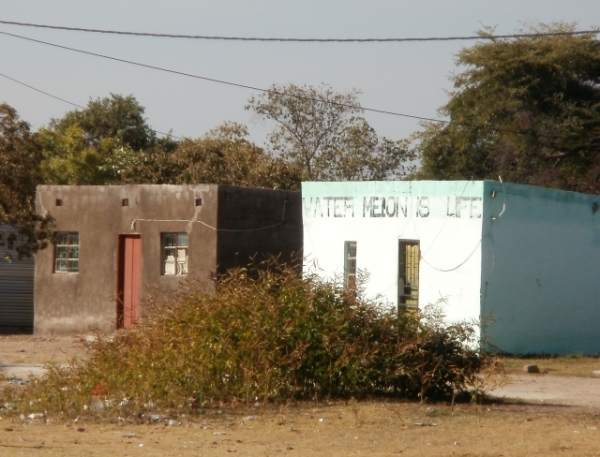



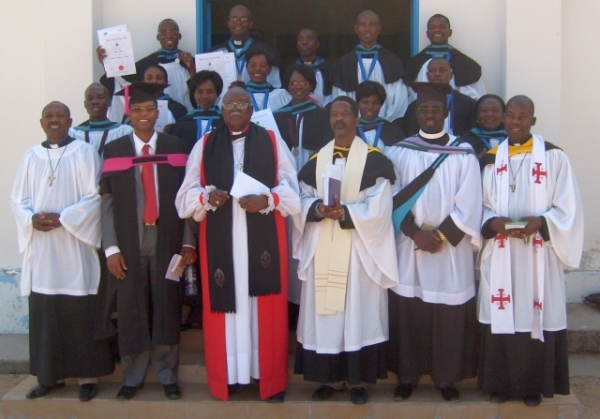


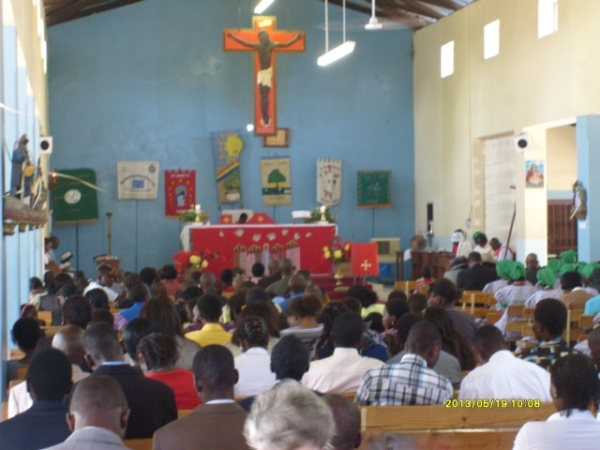


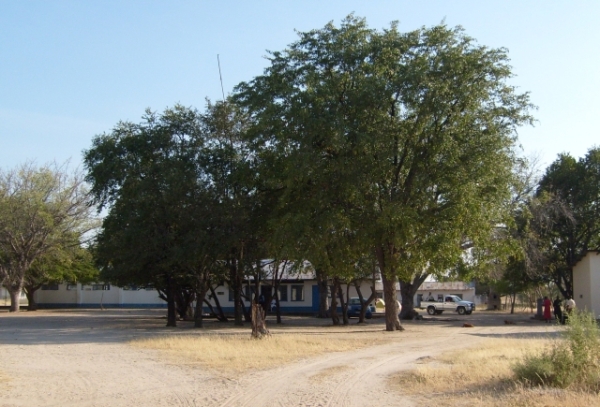





Wonderful to read this, Steve. Including so glad Nancy did hook you up with Loth Chappel Haukongo, with his scrapbook and his delighted memories of the trip** back from Synod. Did you know that he BURIED it during the 20 or so years of S.Africa’s military rule of Ovamboland (oops … “Owambo”), finally digging it up around Independence time (1990) ?
** btw, the other student who came back with us from Synod, who you have in that beautiful photo somewhere else with you and Thomas Rhuhoro in Kamanjab, was Gideon Iileka.
Yes, and I put Gideon and Thomas’s names in the caption, but was having software problems and had to write and edit the post using Internet Explorer instead of Firefox, and caption got lost.